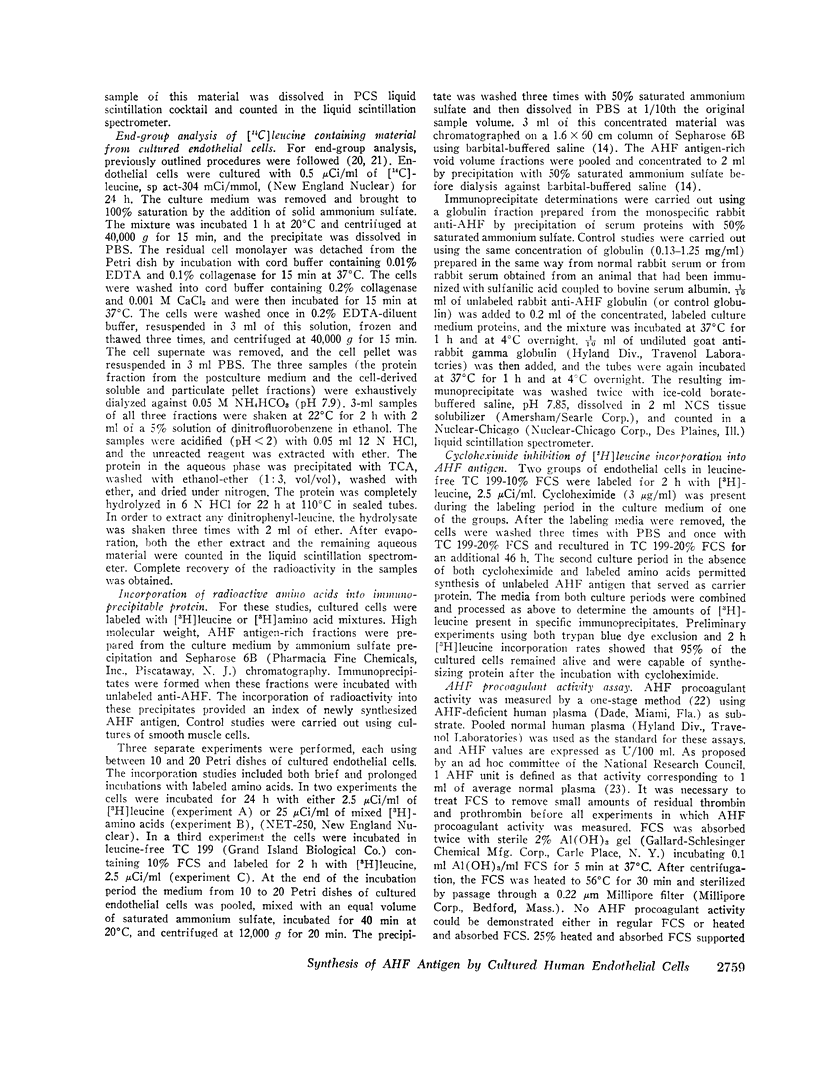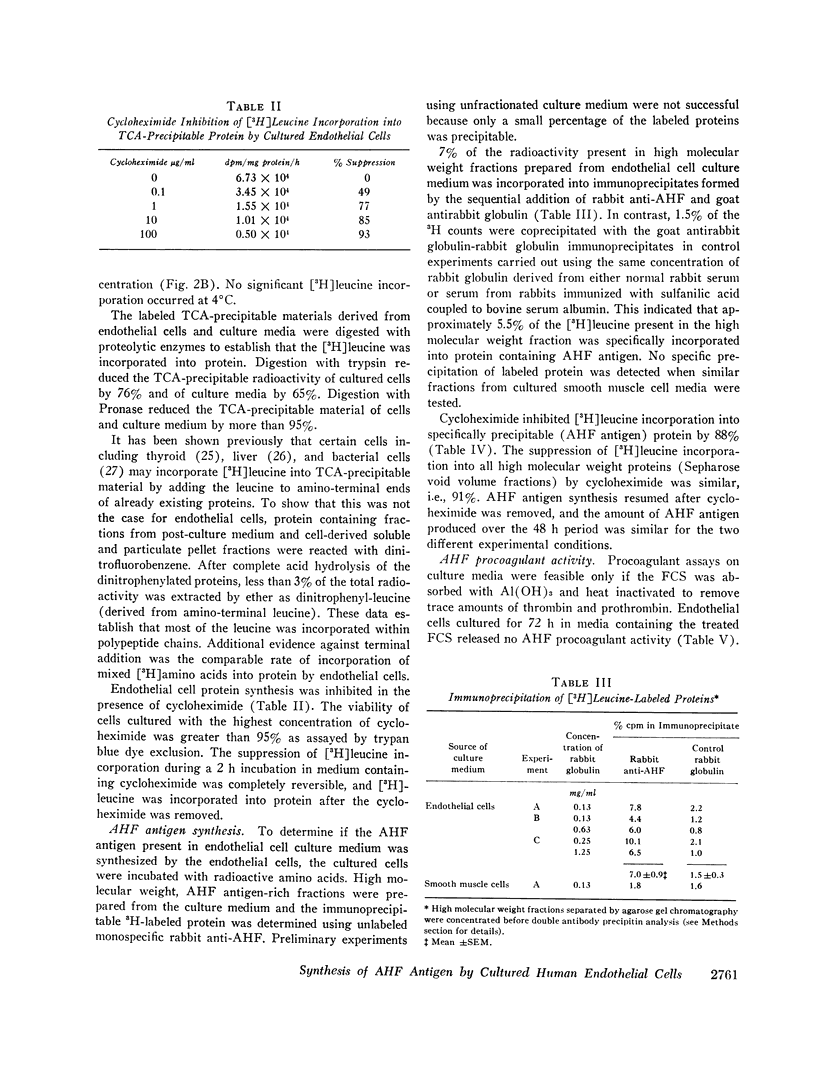Abstract
Antihemophilic factor (AHF, Factor VIII) antigen has been demonstrated in cultured human endothelial cells by immunofluorescence studies using monospecific rabbit antibody to human AHF. Control studies with cultured human smooth muscle cells and human fibroblasts were negative. By radioimmunoassay it was demonstrated that cultured human endothelial cells contain AHF antigen which is released into the culture medium. Cultured smooth muscle cells and fibroblasts did not have this property. Cultured endothelial cells incorporated radioactive amino acids into high molecular weight, AHF antigen-rich protein fractions prepared from the culture media, 7% of the radioactive amino acid counts incorporated into this material were precipitated by globulin prepared from rabbit anti-AHF whereas normal rabbit globulin precipitated only 1.5% of the counts. Although cultured endothelial cells actively synthesize AHF antigen, AHF procoagulant activity was not detected in the culture medium. Studies seeking a basis for the lack of procoagulant activity have not clarified this deficiency, but they have established that exogenous AHF procoagulant activity is not inactivated by the tissue culture system.
Full text
PDF







Images in this article
Selected References
These references are in PubMed. This may not be the complete list of references from this article.
- BOYSE E. A., OLD L. J., CHOUROULINKOV I. CYTOTOXIC TEST FOR DEMONSTRATION OF MOUSE ANTIBODY. Methods Med Res. 1964;10:39–47. [PubMed] [Google Scholar]
- BRECKENRIDGE R. T., RATNOFF C. D. Studies on the nature of the circulating anticoagulant directed against antihemophilic factor: with notes on an assay for anthemophilic factor. Blood. 1962 Aug;20:137–149. [PubMed] [Google Scholar]
- Barrow E. M., Graham J. B. Kidney antihemophilic factor. Partial purification and some properties. Biochemistry. 1968 Nov;7(11):3917–3925. doi: 10.1021/bi00851a020. [DOI] [PubMed] [Google Scholar]
- Bleyer W. A., Hakami N., Shepard T. H. The development of hemostasis in the human fetus and newborn infant. J Pediatr. 1971 Nov;79(5):838–853. doi: 10.1016/s0022-3476(71)80405-5. [DOI] [PubMed] [Google Scholar]
- Bloom A. L., Giddings J. C., Wilks C. J. Factor 8 on the vascular intima: possible importance in haemostasis and thrombosis. Nat New Biol. 1973 Feb 14;241(111):217–219. doi: 10.1038/newbio241217a0. [DOI] [PubMed] [Google Scholar]
- Bouhasin J. D., Monteleone P., Altay C. Role of the lymphocyte in antihemophilic globulin production: a rise in antihemophilic globulin levels in a hemophilic subject with acute lymphoblastic leukemia. J Lab Clin Med. 1971 Jul;78(1):122–129. [PubMed] [Google Scholar]
- DIDISHEIM P., LEWIS J. H. Congenital disorders of the mechanism for coagulation of blood. Pediatrics. 1958 Sep;22(3):478–493. [PubMed] [Google Scholar]
- Dodds W. J. Storage, release, and synthesis of coagulation factors in isolated perfused organs. Am J Physiol. 1969 Sep;217(3):879–883. doi: 10.1152/ajplegacy.1969.217.3.879. [DOI] [PubMed] [Google Scholar]
- FRAENKEL-CONRAT H., HARRIS J. I., LEVY A. L. Recent developments in techniques for terminal and sequence studies in peptides and proteins. Methods Biochem Anal. 1955;2:359–425. doi: 10.1002/9780470110188.ch12. [DOI] [PubMed] [Google Scholar]
- Gonzalez E. N., Rothfield N. F. Immunoglobulin class and pattern of nuclear fluorescence in systemic lupus erythematosus. N Engl J Med. 1966 Jun 16;274(24):1333–1338. doi: 10.1056/NEJM196606162742401. [DOI] [PubMed] [Google Scholar]
- Hoyer L. W., De los Santos R. P., Hoyer J. R. Antihemophilic factor antigen. Localization in endothelial cells by immunofluorescent microscopy. J Clin Invest. 1973 Nov;52(11):2737–2744. doi: 10.1172/JCI107469. [DOI] [PMC free article] [PubMed] [Google Scholar]
- Hoyer L. W. Immunologic studies of antihemophilic factor (AHF, factor VIII). IV. Radioimmunoassay of AHF antigen. J Lab Clin Med. 1972 Dec;80(6):822–833. [PubMed] [Google Scholar]
- Jaffe E. A., Nachman R. L., Becker C. G., Minick C. R. Culture of human endothelial cells derived from umbilical veins. Identification by morphologic and immunologic criteria. J Clin Invest. 1973 Nov;52(11):2745–2756. doi: 10.1172/JCI107470. [DOI] [PMC free article] [PubMed] [Google Scholar]
- KAJI A., KAJI H., NOVELLI G. D. SOLUBLE AMINO ACID-INCORPORATING SYSTEM. I. PREPARATION OF THE SYSTEM AND NATURE OF THE REACTION. J Biol Chem. 1965 Mar;240:1185–1191. [PubMed] [Google Scholar]
- KEKWICK R. A., WALTON P. L. Conditions influencing the stability of human antihaemophilic factor. Nature. 1962 Jun 2;194:878–879. doi: 10.1038/194878a0. [DOI] [PubMed] [Google Scholar]
- LOWRY O. H., ROSEBROUGH N. J., FARR A. L., RANDALL R. J. Protein measurement with the Folin phenol reagent. J Biol Chem. 1951 Nov;193(1):265–275. [PubMed] [Google Scholar]
- Legaz M. E., Schmer G., Counts R. B., Davie E. W. Isolation and characterization of human Factor VIII (antihemophilic factor). J Biol Chem. 1973 Jun 10;248(11):3946–3955. [PubMed] [Google Scholar]
- Marchesi S. L., Shulman N. R., Gralnick H. R. Studies on the purification and characterization of human factor 8. J Clin Invest. 1972 Aug;51(8):2151–2161. doi: 10.1172/JCI107022. [DOI] [PMC free article] [PubMed] [Google Scholar]
- Norman J. C., Lambilliotte J. P., Kojima Y., Sise H. S. Antihemophilic factor release by perfused liver and spleen: relationship to hemophilia. Science. 1967 Nov;158(3804):1060–1061. doi: 10.1126/science.158.3804.1060. [DOI] [PubMed] [Google Scholar]
- Osterud B., Rapaport S. I., Schiffman S., Chong M. M. Formation of intrinsic factor-X activator activity, with special reference to the role of thrombin. Br J Haematol. 1971 Dec;21(6):643–660. doi: 10.1111/j.1365-2141.1971.tb02727.x. [DOI] [PubMed] [Google Scholar]
- Owen W. G., Wagner R. H. Antihemophilic factor: separation of an active fragment following dissociation by salts or detergents. Thromb Diath Haemorrh. 1972 Jul 31;27(3):502–515. [PubMed] [Google Scholar]
- POOL J. G., SPAET T. H. Ethionine-induced depression of plasma antihemophilic globulin in the rat. Proc Soc Exp Biol Med. 1954 Oct;87(1):54–57. doi: 10.3181/00379727-87-21283. [DOI] [PubMed] [Google Scholar]
- Schwartz J. H., Castellucci V. F., Kandel E. R. Functioning of identified neurons and synapses in abdominal ganglion of Aplysia in absence of protein synthesis. J Neurophysiol. 1971 Nov;34(6):939–953. doi: 10.1152/jn.1971.34.6.939. [DOI] [PubMed] [Google Scholar]
- Soffer R. L. Enzymatic modification of proteins. II. Purification and properties of the arginyl transfer ribonucleic acid-protein transferase from rabbit liver cytoplasm. J Biol Chem. 1970 Feb 25;245(4):731–737. [PubMed] [Google Scholar]
- Soffer R. L. The arginine transfer reaction. Biochim Biophys Acta. 1968 Jan 29;155(1):228–240. doi: 10.1016/0005-2787(68)90352-3. [DOI] [PubMed] [Google Scholar]
- Stites D. P., Hershgold E. J., Perlman J. D., Fudenberg H. H. Factor 8 detection by hemagglutination inhibition: hemophilia A and von Willebrand's disease. Science. 1971 Jan 15;171(3967):196–197. doi: 10.1126/science.171.3967.196. [DOI] [PubMed] [Google Scholar]
- Weiss H. J., Kochwa S. Molecular forms of antihaemophilic globulin in plasma, cryoprecipitate and after thrombin activation. Br J Haematol. 1970 Jan;18(1):89–100. doi: 10.1111/j.1365-2141.1970.tb01421.x. [DOI] [PubMed] [Google Scholar]
- Weiss H. J., Phillips L. L., Rosner W. Separation of sub-units of antihemophilic factor (AHF) by agarose gel chromatography. Thromb Diath Haemorrh. 1972 Apr 30;27(2):212–219. [PubMed] [Google Scholar]
- Zimmerman T. S., Ratnoff O. D., Powell A. E. Immunologic differentiation of classic hemophilia (factor 8 deficiency) and von Willebrand's dissase, with observations on combined deficiencies of antihemophilic factor and proaccelerin (factor V) and on an acquired circulating anticoagulant against antihemophilic factor. J Clin Invest. 1971 Jan;50(1):244–254. doi: 10.1172/JCI106480. [DOI] [PMC free article] [PubMed] [Google Scholar]



